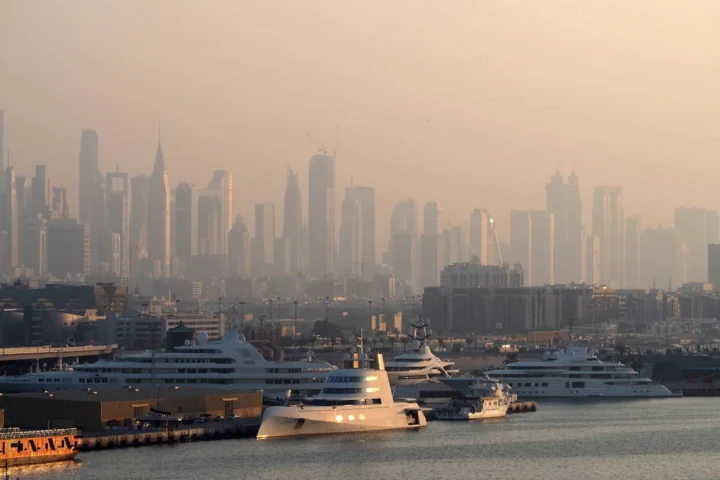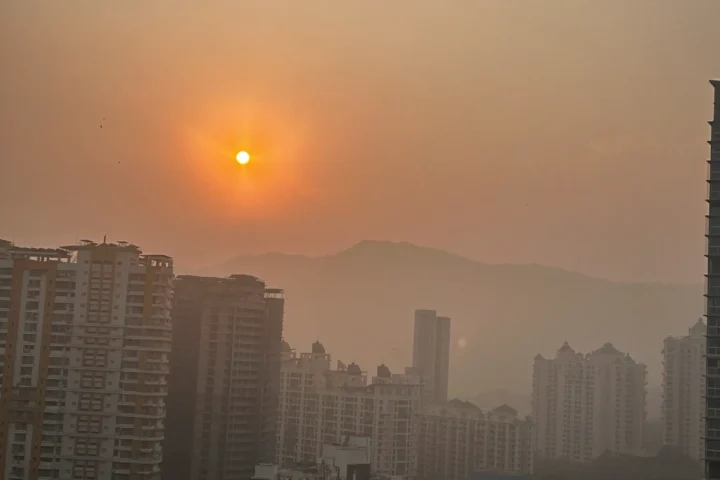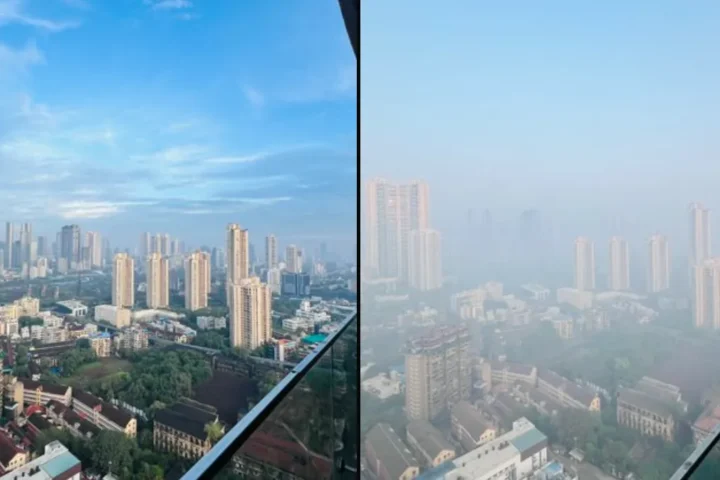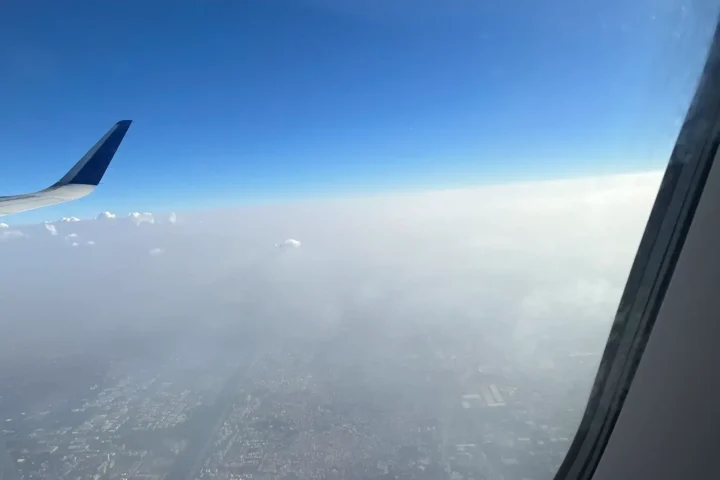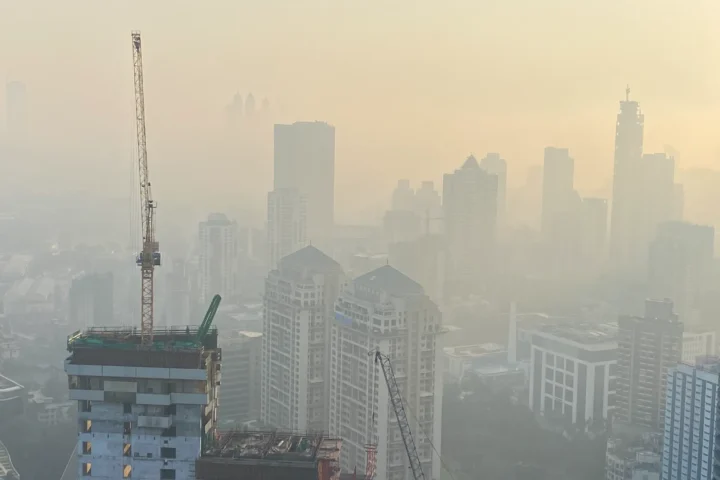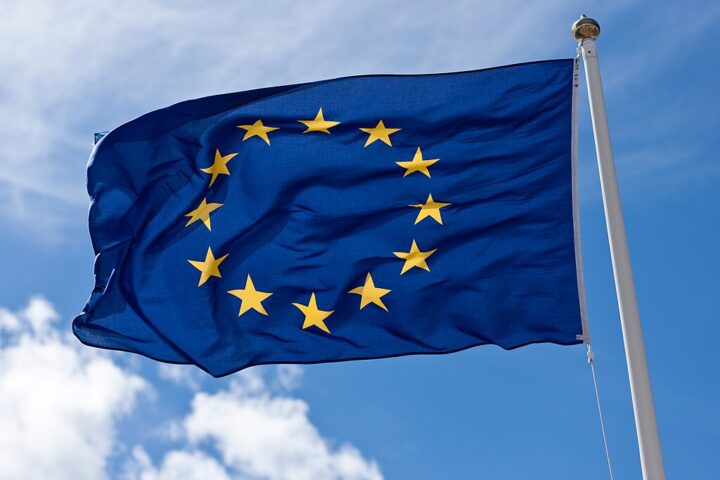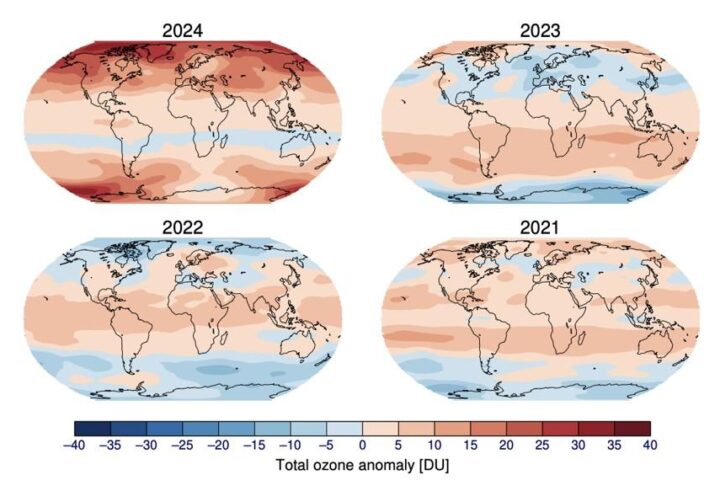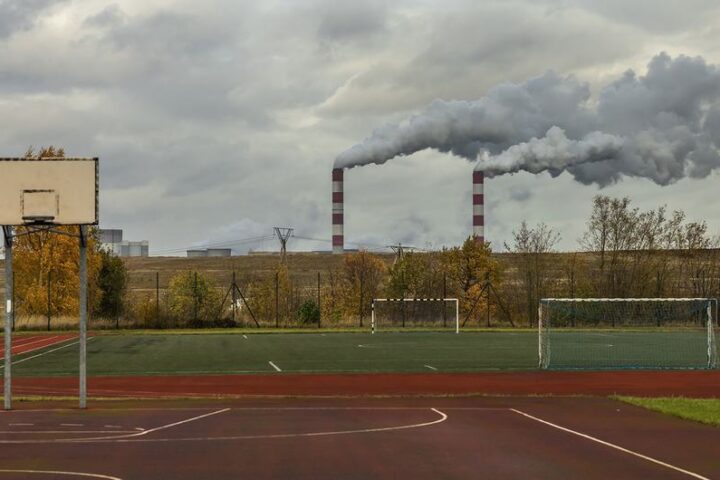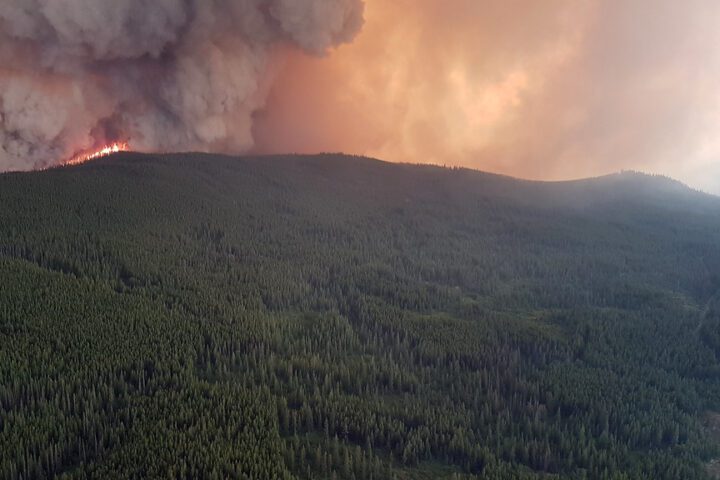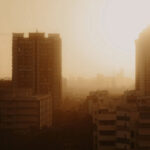Millions of Americans woke up to an eerie orange glow this week as thick clouds of wildfire smoke drifted south from Canada, transforming familiar neighborhoods into scenes that look more like Mars than the Midwest. Around 200 active wildfires are burning across Canada, with approximately 100 considered “out of control,” according to the Canadian Interagency Forest Fire Centre. The smoke has triggered air quality alerts from Minnesota to Maine, affecting millions of people and forcing communities to confront a reality where clear blue skies can no longer be taken for granted.
Air Quality Emergency Spans Multiple States
Poor air quality may persist through Monday, meaning sensitive groups such as pregnant people, newborns, older adults or those with respiratory or heart problems should limit time outdoors. The scope reaches far beyond what weather maps typically show. Marquette, Michigan, had an air quality index (AQI) rating of 817 on Tuesday afternoon, while the town of Hancock, Michigan, peaked over 800 late Tuesday morning.
Among the major cities in the world, Chicago has the second-worst air quality on Thursday. The Twin Cities area experienced some of the worst conditions in the Midwest, with conditions in parts of Minnesota, Wisconsin and Michigan rated “very unhealthy” Tuesday.
Current alerts remain in effect across northern Minnesota, northern Indiana, southern Michigan, and northern New York. The Minnesota Pollution Control Agency issued an alert for almost the entire state into Wednesday, but the Twin Cities area got the worst of it in the Midwest on Tuesday.
The Science Behind Cross-Border Smoke Transport
What makes this crisis particularly challenging is how wildfire smoke travels. Winds high in the atmosphere pushed that smoke into the Upper Midwest on Friday, and the plumes continued to travel southeast over the weekend, with smoke reaching as far as Florida. Wildfire smoke can travel hundreds or thousands of miles, posing health risks to people far away from an active blaze.
Saskatchewan Premier Scott Moe declared a state of emergency for the Canadian province on May 29, 2025 amid a spate of wildfire outbreaks. The neighboring province of Manitoba had first declared a state of emergency on May 28, 2025 as wildfires forced some 17,000 people to flee.
“Using the latest science and data, New York continues to track air quality conditions across the State to keep New York communities safe,” Governor Kathy Hochul said. “As temperatures begin to climb during the summer months and less predictable factors like distant wildfires occur, I strongly encourage New Yorkers to stay informed and prepare for changes in air quality by paying attention to the State’s Air Quality Health Advisories and take necessary precautions to stay safe.”
The meteorological mechanics involve complex atmospheric patterns that create what scientists call a “conveyor belt” of hazardous air. Aircraft and dozens of personnel from other Canadian provinces and the United States — including Arizona, Oregon and Alaska — are being sent to help fight the wildfires.
Understanding PM2.5: The Invisible Threat
The real danger lies in particles so small you cannot see them. These microscopic particles, measuring 10 microns or smaller (known as PM10) can be inhaled into the lungs, and fine particulate matter that are 2.5 microns or less (known as PM2.5, smaller than the average human hair), can penetrate deep into the lungs and even enter the bloodstream.
Exposure to high amounts of smoke can quickly result in symptoms such as itchy or irritated eyes, coughing, chest pain, irritated sinuses, wheezing, and a fast heartbeat, according to the Centers for Disease Control and Prevention (CDC). The Illinois Environmental Protection Agency specifically warns that sensitive individuals should watch for “wheezing, coughing, a fast heartbeat, fatigue, chest pain, and shortness of breath. If symptoms worsen, you should call your physician or 911.”
Exposure to high concentrations of wildfire smoke “can cause persistent coughing, phlegm, wheezing, and difficulty breathing. Even in healthy people, exposures to fine particles can potentially lead to transient reductions in lung function, and pulmonary inflammation.”
Short-term risks to wildfire exposure may cause coughing, wheezing, difficulty breathing, bronchitis, increased risk of asthma and other respiratory distress. If exposed over days or weeks, you may even see reduced lung function.
Who Faces the Greatest Risk
Vulnerable populations bear a disproportionate burden during smoke events. New York State Health Commissioner Dr. James McDonald explained: “Pollutants like particulate matter from wildfires or ground-level ozone can pose serious health risks—especially for those with heart conditions or lung disease such as asthma, as well as the very young, those over 65 years old and pregnant people.”
Children face particular vulnerability because they breathe more air per unit of body weight than adults. Fine particulate matter from wildfire smoke triggers inflammation in airways, aggravating underlying medical conditions. Healthcare facilities are already reporting impacts. Hennepin Healthcare, the main emergency hospital in Minneapolis, has seen a slight increase in visits by patients with respiratory symptoms aggravated by the dirty air.
Protection Strategies: N95 Masks and Beyond
Respiratory Protection
Well-made N95 and KN95 face masks, such as those worn during the COVID-19 pandemic, are your best bet against the harmful chemicals in wildfire smoke. If fitted and worn correctly, the N95 mask filters out 95% of particles larger than 0.3 microns, so it’s very efficient at keeping out the 2.5-micron particles in wildfire smoke.
The fine particulate matter (PM2.5) in wildfire smoke is similar in size to COVID-19 particles, making masks like N95s highly effective in both scenarios and can protect against both viruses and smoke particles. However, proper fit is crucial. Tight-fitting respirators such as N95s need a tight seal to the face to provide adequate protection from wildfire smoke.
People can protect themselves by staying indoors or by wearing N95 masks. Strykowski added that they must be N95s because the cloth masks many people used during the COVID-19 pandemic don’t provide enough filtration.
Indoor Air Quality Management
Creating clean air refuges within homes becomes essential during smoke events. Most home systems use a low efficiency fiberglass filter that is 1 inch thick and has a Minimum Efficiency Reporting Value (MERV) rating of 1–4. Replacing this filter with a medium efficiency filter (MERV 5–8) can significantly improve the air quality in a home. Higher efficiency filters (MERV 9–12) will work even better, and a true high efficiency filter (MERV 13–16) can remove as much as 95% of the particles that pass through it.
For optimal protection against wildfire smoke, the U.S. Environmental Protection Agency (EPA) recommends using air filters with a Minimum Efficiency Reporting Value of 13 (MERV 13) or higher in HVAC systems. Most furnaces and HVAC systems can accommodate a MERV 13 filter without creating equipment problems, provided that the filter is replaced frequently.
Portable air cleaners provide additional protection. Portable air cleaners are self-contained air filtration appliances that can be used alone or with enhanced central air filtration to effectively remove particles. The portable air cleaner should have a high-efficiency HEPA filter and be the right size device for the room.
Creating Clean Air Spaces
For households without central air conditioning, another alternative is a do-it-yourself (DIY) air cleaner. These are made with a box fan and MERV 13 air filters. This approach helps families create designated clean air spaces within their homes.
By focusing on one room or area, cleaning the air becomes more manageable and everyone has a safe place to be during periods of intense wildfire smoke. The strategy proves particularly valuable for lower-income households that may lack access to central air conditioning systems.
Economic and Community Impact
The impacts extend beyond immediate health concerns. Event cancellations, like outdoor sporting events and community gatherings, represent just the beginning of economic consequences. Tourism-dependent communities face visitor cancellations, while outdoor workers must modify schedules or cease operations entirely.
U.S. crews and aviation resources have been deployed to Canada, with additional resources expected in the coming weeks. This international cooperation demonstrates how wildfire management has become a truly transnational challenge requiring coordinated responses.
Similar Posts:
Climate Change Connection
The hotter, drying conditions that come with climate change are making these annual fires across North America, and in other parts of the world, the new norm. Wildfires are happening more frequently, getting bigger, and emitting more smoke.
DEC Commissioner Amanda Lefton emphasized the importance of awareness: “It is critical that New Yorkers be Air Quality Aware this summer to stay safe and healthy. DEC continues to track air quality across the state and works with our partners at the Department of Health to keep the public informed about how to protect themselves and their families and reduce their exposure to air pollution.”
The U.S. has also battled increasingly devastating wildfires over recent years as climate change has made larger wildfires more likely and more intense. This reality requires communities to develop long-term adaptation strategies rather than treating smoke events as temporary disruptions.
Historical Context and Frequency Trends
In 2023, smoke from Canadian wildfires turned skies orange in the Northeastern U.S. and led to unhealthy air quality levels in New York City, Boston, Philadelphia and Washington, D.C. The 2023 Canadian wildfire season was the most destructive on record, affecting all 13 of the country’s provinces and territories. The 2024 wildfire season ranked among the worst.
As documented by NOAA satellites, wildfires are becoming a more persistent threat. By 2025, some “zombie fires” in Alberta and British Columbia had continued to smolder under the snow, persisting for more than two years. As of June 5, 2025, there have been 1,746 fires throughout Canada and 2.6 million hectares consumed—an area larger than Vermont.
U.S. officials noted that while fire activity in Canada is roughly 40% above average, fire conditions in the U.S. remain relatively manageable compared to previous years.
International Smoke Transport
The reach of this crisis extends far beyond North America. Since mid-May, NOAA satellites have been closely monitoring heat signatures and thick plumes of smoke from wildfires burning across Canada. Driven by heat, drought, and dry conditions, more than 160 fires kicked off the country’s wildfire season, primarily in Manitoba, Ontario, and Saskatchewan.
Canada is having another bad wildfire season, and over 26,000 people in three provinces have been forced to evacuate. The smoke is even reaching Europe, where it is causing hazy skies but isn’t expected to affect surface-air quality.
NOAA satellites have documented phenomena associated with the wildfires, including pyrocumulonimbus clouds captured by the GOES West (GOES-18) satellite, which billowed from wildfires in Alberta, Canada. These are thunderstorms that can form above wildfires due to intense heat and rising smoke.
This intercontinental transport demonstrates how atmospheric conditions connect distant regions through shared air masses, making wildfire smoke a truly global environmental challenge.
Workplace Protections
With exceptions, section 5141.1, Protection from Wildfire Smoke, applies to workplaces and operations where the current Air Quality Index (AQI) for PM2.5 particulate is 151 or greater (“unhealthy”) and where the employer should reasonably anticipate that employees may be exposed to wildfire smoke.
The employer must provide a sufficient number of respirators for employee use on a voluntary basis when the current AQI for PM2.5 is equal to or greater than 151 but does not exceed 500. The employer must require employees to use respirators when the current AQI for PM2.5 is greater than 500.
Long-term Health Implications
Recent research reveals long-term consequences of smoke exposure. This week, an analysis published in the journal Epidemiology found that the risk of going to the hospital for cardiorespiratory problems like hypertension or heart attack rose for months after exposure to smoke — showing that the health effects can linger long after the fires themselves have been put out.
A study last year found that people who inhaled the smoke in New York and New Jersey were likely exposed to extremely large concentrations of fine particulate matter — tiny particles in the air that can penetrate deep into the lungs. Short-term exposure to these particles can increase the risk of cardiac arrest, asthma attacks or stroke, while long-term exposure can increase the risk of heart disease, lung cancer and chronic kidney disease.
Preparing for Future Events
Securing an air cleaner before a smoke event occurs is particularly important for patients in at-risk groups. During a smoke event it may be hazardous to go outside or drive, and appropriate devices may be in short supply.
Steps for your patients to take before fire season include: Know where to find alerts: Point patients to sources in your area for alerts and health warnings about smoke and fire risk, including air quality reports, public service announcements, and social media warnings.
Community preparedness requires coordinated planning that addresses both immediate health needs and long-term adaptation. Libraries, community centers, and shopping malls often serve as informal clean air shelters, though formal designation and preparation of these spaces could enhance public health protection.
Environmental Justice Considerations
Wildfire smoke impacts affect communities unequally. Low-income neighborhoods often lack access to air conditioning, forcing residents to choose between heat exposure and smoke inhalation. Outdoor workers, including agricultural laborers and construction crews, face occupational hazards that cannot be easily mitigated.
Indigenous communities, particularly those in remote areas closer to fire sources, experience disproportionate impacts while often having limited healthcare access for treating smoke-related health effects.
Monitoring and Information Resources
New York State provides comprehensive air quality monitoring using data collected from more than 50 sites across the state. The New York State Department of Environmental Conservation and Department of Health issue Air Quality Health Advisories when meteorologists predict levels of pollution are expected to exceed an Air Quality Index value of 100.
Dr. James McDonald encouraged daily awareness: “Just as you check the weather on your phone each morning, we encourage all New Yorkers to visit airnow.gov for the latest air quality forecast and be on the lookout for Air Quality Health Advisories from the Department of Environmental Conservation and the Department of Health. When air quality is poor, protect yourself by staying inside, reduce exposure and minimize exertion when outdoors.”
The most reliable alerts come from state, local, or federal government agencies. The AirNow web site includes links to Current Advisories. Real-time monitoring helps individuals and families make informed decisions about outdoor activities and protection measures.
The AirNow.gov website provides localized air quality data, while state environmental agencies issue specific health advisories tailored to regional conditions. Mobile apps and emergency alert systems help ensure communities receive timely warnings about deteriorating air quality.
What Communities Can Do Now
Effective community response integrates scientific understanding with practical action. Success depends not on preventing all smoke events but on building resilience that protects vulnerable populations while maintaining community function during challenging air quality conditions.
Local health departments can establish networks of clean air facilities, while schools and employers can develop protocols for modifying outdoor activities based on real-time air quality data. Emergency planning should include provisions for extending clean air shelter capacity during prolonged smoke events.

The Path Forward
Fischer says we’d all better get used to it. The smoke that crosses the U.S.-Canada border carries an urgent message about environmental conditions that require long-term adaptation rather than short-term accommodation.
Building resilience requires recognition that clean air can no longer be taken for granted. Instead, it must be actively protected through coordinated efforts spanning international borders, government levels, and community organizations.
The 2025 Canadian wildfire smoke events affecting multiple U.S. states represent a fundamental shift in North American environmental conditions. How communities respond to this challenge will determine whether future generations inherit prepared communities or ones caught repeatedly off-guard by predictable consequences of a changing climate.
Effective adaptation demands integration of protective technology, community planning, and individual preparedness. The expertise developed in managing these events will prove invaluable as climate change continues reshaping environmental conditions across North America.
For current air quality information, visit AirNow.gov. During smoke events, limit outdoor activities when AQI exceeds 150, and consider using NIOSH-approved N95 respirators for necessary outdoor exposure. Upgrade home air filters to MERV 13 or higher, and ensure adequate indoor ventilation controls.


